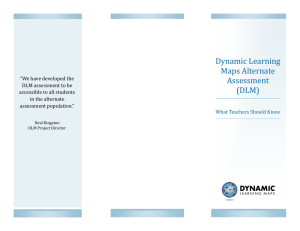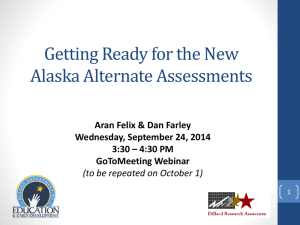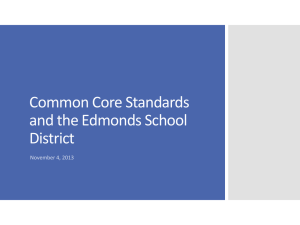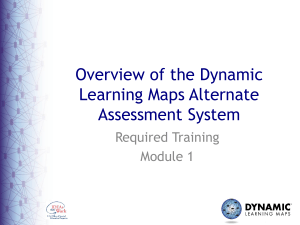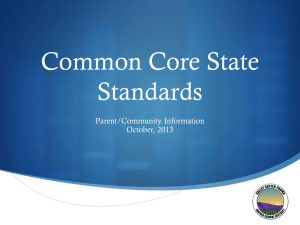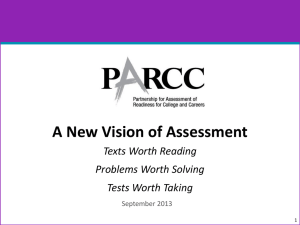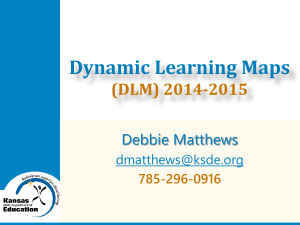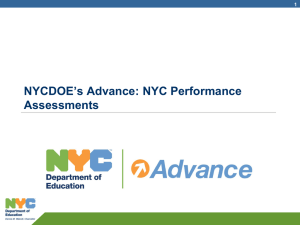Dynamic Learning Maps Presentation
advertisement
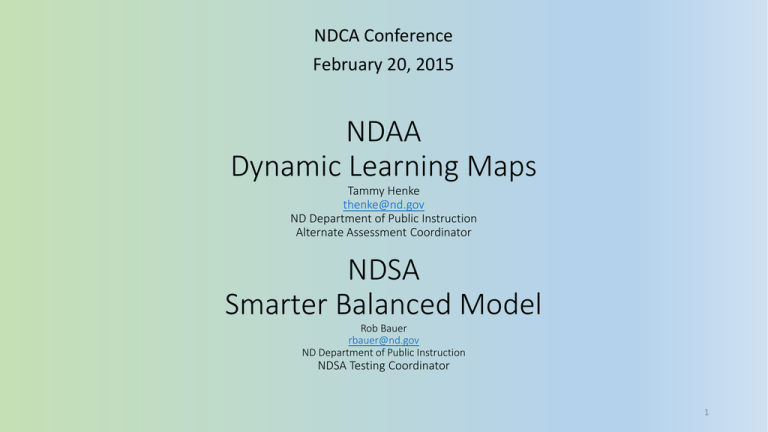
NDCA Conference February 20, 2015 NDAA Dynamic Learning Maps Tammy Henke thenke@nd.gov ND Department of Public Instruction Alternate Assessment Coordinator NDSA Smarter Balanced Model Rob Bauer rbauer@nd.gov ND Department of Public Instruction NDSA Testing Coordinator 1 2014-15 Test Windows Test Subject Grades Test Window Format Contact Rob Bauer 701-328-2224 rgbauer@nd.gov NDSA (CTB/McGraw-Hill) Science 4, 8, 11 October 20 – November 7, 2014 Paper & Pencil NDSA (Smarter Balanced) English Language Arts and Mathematics 3-8 Last 12 weeks of the school year, but no sooner than March 16, 2015. Online 11 Last 6 weeks of the school year, but no sooner than March 16, 2015. Online NDAA1 (State Alternate Model) Science NDAA1 (Dynamic Learning Maps) English Language Arts and Mathematics 4, 8, 11 3 - 8, 11 November 3 – December 20, 2014 March 16 – June 1, 2015 Rob Bauer 701-328-2224 rgbauer@nd.gov Online Tammy Henke 701-328-2277 thenke@nd.gov Online Tammy Henke 701-328-2277 thenke@nd.gov 2 NDSA Smarter Balanced Model 3 A Balanced Assessment System Available 2015-16 in North Dakota Digital Library on Formative Assessment • • • An online collection of resources aligned to the Common Core that will support K-12 teachers’ use of the formative assessment process. • Assessment literacy modules • Exemplar instructional modules • Education resources submitted and vetted by teachers Teachers can rate materials and share their expertise with educators across the country. Accounts can be established by DPI for all educators in districts requesting access. Districts should contact Rob Bauer for account creation (rgbauer@nd.gov). Interim Assessments – Available in 2015-16 Available 2015-16 in North Dakota • Optional assessments administered in grades 3-8 and high school • • • For North Dakota, the Interim Assessments will likely be designed with only machine-scorable test items. At the high school level, the assessments may be administered in grades 9, 10, 11, and/or 12. Allow schools to check in on student progress and provide information to inform instruction Flexible administration options • • Interim Comprehensive Assessments use the same design as the summative assessments. Interim Assessment Blocks focus on smaller sets of related standards and provide more detailed information for instructional purposes. The Smarter Balanced Assessment System • • Administered in the last 12 weeks of the school year Students will receive composite scores for each subject area and the following claim-level scores: • • English language arts • reading, writing, listening, and research; Math • concepts and procedures, problem solving and modeling/data analysis, and communicating reasoning 7 Summative Assessment Testing Windows Each district will establish a schedule for the administration of the Smarter Balanced summative assessments using a testing window as defined below: Grades 3–8 • Testing shall not begin until at least sixty-six percent (66%) of a school’s annual instructional days have been completed, but no sooner than March 16, 2015. • Testing may continue up to and including the last day of school. Grade 11 • Testing shall not begin until at least eighty percent (80%) of a school’s annual instructional days have been completed, but not sooner than March 16, 2015. A typical North Dakota high school might begin testing between April 1 and April 20, 2015, depending on the school calendar. • Testing may continue up to and including the last day of school. • [Note: Sixty-six percent of a school year occurs after the 120th instructional day in a 180-day year, leaving a twelve-week window for grades 3–8 testing; eighty percent of a school year occurs after the 144th instructional day in a 180-day year, leaving a seven-week window for grade eleven testing.] 8 Smarter Balanced Assessment CAT Classroom Activity Performance Task 9 SAMPLE ADMINISTRATION SEQUENCE Day 1 Day 2 Day 3 Day 4 ELA ELA Classroom Activity ELA ELA Part 1 Part 2 CAT CA PT PT Day 7 Day 8 Day 9 Math Math Classroom Activity Math CAT CA PT Administer the performance task within three days of the Classroom Activity. • ELA PT—2 sessions • Math PT—1 session Summative Assessments – Estimated Testing Time Test Type English Language Arts Mathematics COMBINED Grades CAT Perf. Task Only Total Class Activity Total 3-5 1:30 2:00 3:30 :30 4:00 6-8 1:30 2:00 3:30 :30 4:00 11 2:00 2:00 4:00 :30 4:30 3-5 1:30 1:00 2:30 :30 3:00 6-8 2:00 1:00 3:00 :30 3:30 11 2:00 1:30 3:30 :30 4:00 3-5 3:00 3:00 6:00 1:00 7:00 6-8 3:30 3:00 6:30 1:00 7:30 11 4:00 3:30 7:30 1:00 8:30 Times are estimates of test length for most students. Smarter Balanced assessments are designed as untimed tests; some students may need and should be afforded more time than shown in this table. Technology Preparation • DPI is partnering with EduTech to deliver webinars and face-to-face trainings on preparation for the online assessment. • Training includes information on • • • • system requirements network requirements supported devices Secure browsers • Contact EduTech Help desk for more information • 800-774-1091 • help@k12.nd.us 12 Measured Progress North Dakota’s Smarter Balanced Test Vendor • Measured Progress (MP) has been selected as the test vendor that has overall management and responsibility for delivery of the online assessment. • MP will provide a North Dakota test portal with the Test Administration Manual, training modules for test administration, and secure access to student test records. • NDSAsmarter.measuredprogress.org • Test Administrators will administer the assessment through the MP portal. • MP will provide a North Dakota Service Desk phone and email address for support. • 800-929-3757 • NDSAservicedesk@measuredprogress.org 13 Preparation of Student Records for Online Testing Upload Student Enrollment Records from STARS Upload Student Accommodations & Designated Support Records from TieNet Activate Account IDs for District Superintendents & District Test Coordinators Activate Account IDs for School Test Coordinators, Test Administrators, and additional District Test Coordinators Enter Local Student Records not entered by State Enter Accommodations Not Uploaded from TieNet Enter Non-IEP Designated Supports Verify Accuracy of Student Records Test Administration Setup Student Testing Administration & Registration Tools (ART) Accessibility and Accommodations For the secure assessments, a state can only provide students with the universal tools, designated supports, and accommodations that are included in the Smarter Balanced Usability, Accessibility, and Accommodations Guidelines. 15 Universal Tools Embedded Breaks, Calculator, Digital Notepad, English Dictionary, English Glossary, Expandable Passages, Global Notes, Highlighter, Keyboard Navigation, Mark for Review, Math Tools, Spell Check, Strikethrough, Writing Tools, Zoom Non-embedded Breaks, English Dictionary, Scratch Paper, Thesaurus Designated Supports Embedded Color Contrast, Masking, Text-to-speech, Translated Test Directions, Translations (Glossary), Translations (Stacked), Turn off Any Universal Tools Non-embedded Bilingual Dictionary, Color Contrast, Color Overlay, Magnification, Read Aloud, Scribe, Separate Setting, Translated Test Directions, Translation (Glossary) Accommodations Embedded American Sign Language, Braille, Closed Captioning, Text-tospeech Non-embedded Abacus, Alternate Response Options, Calculator, Multiplication Table, Noise Buffers, Print on Demand, Read Aloud, Scribe, Speech-to-text 16 Claims for the ELA/Literacy Summative Assessment Overall Claim for Grades 3-8 “Students can demonstrate progress toward college and career readiness in English Language arts and literacy.” Overall Claim for Grade 11 “Students can demonstrate college and career readiness in English language arts and literacy.” Claim #1 - Reading “Students can read closely and analytically to comprehend a range of increasingly complex literary and informational texts.” Claim #2 - Writing “Students can produce effective and well-grounded writing for a range of purposes and audiences.” Claim #3 - Speaking and Listening Claim #4 - Research/Inquiry “Students can employ effective speaking and listening skills for a range of purposes and audiences.” “Students can engage in research and inquiry to investigate topics, and to analyze, integrate, and present information.” Claims for the Mathematics Summative Assessment Overall Claim for Grades 3-8 Overall Claim for Grade 11 “Students can demonstrate progress toward college and career readiness in mathematics.” “Students can demonstrate college and career readiness in mathematics.” Claim #1 - Concepts & Procedures “Students can explain and apply mathematical concepts and interpret and carry out mathematical procedures with precision and fluency.” Claim #2 - Problem Solving “Students can solve a range of complex well-posed problems in pure and applied mathematics, making productive use of knowledge and problem solving strategies.” Claim #3 - Communicating Reasoning “Students can clearly and precisely construct viable arguments to support their own reasoning and to critique the reasoning of others.” Claim #4 - Modeling and Data Analysis “Students can analyze complex, real-world scenarios and can construct and use mathematical models to interpret and solve problems.” NDAA Dynamic Learning Maps 19 “We are developing the DLM assessment where supporting instruction is in the very design of the assessment, not an afterthought, so that all children can meet high standards.” Neal Kingston DLM Project Director 20 • All children participate in state accountability assessments. • The Dynamic Learning Maps™ Alternate Assessment System (DLM™) is an instructionally relevant system that supports student learning and measures what students with significant cognitive disabilities know and can do. 21 DLM Assessment Design • The DLM system is designed to map a student’s learning throughout the year. • There are two testing phases. • The Instructionally Embedded occurs in the fall, winter, and early spring. Students are assessed at least once on each Essential Element that is chosen by a teacher before instruction. • Results factor into overall accountability reports. 22 DLM Assessment Design • The Spring Testing window students are re-assessed on a subset of the previously tested Essential Elements . • The system selects five testlets per content area. • These also factor into overall accountability reports. 23 Essential Elements • The Essential Elements (EEs) are specific statements of knowledge and skills that link the academic expectations for students with significant cognitive disabilities to grade-level standards. • The EEs specify academic targets, while the learning map clarifies how students can reach the specified standard. • EEs included in the blueprint for each grade are listed in blueprint documents. www.dynamiclearningmaps.org 24 Assessment Results • The DLM scoring system works differently from traditional alternate assessments. • The system uses the student’s performance on instructionally embedded assessments and spring testing and compares it to the learning map to determine the student’s level of mastery on the Essential Elements. • There are no raw scores, percentages, or scale scores. 25 Assessment Results • Each student’s results will include information about performance on the assessed EEs. • Score reports will be provided at the individual student level and include: • Essential Element Learning Profile • Performance in each conceptual area • Overall performance 26 Test Administration Time All times noted are estimates and ranges. • Total testing time varies depending on the number of EEs assessed and a student’s unique learning needs. • Testlets may be taken separately across multiple testing sessions as long as they are all completed within the testing window. • Instructionally Embedded Testlets: Time Per Testlet • • • 5-10 minutes for mathematics 10-15 minutes for reading 10-20 minutes for writing • Spring Testing: Total Testing Time • 60-75 minutes in ELA • 35-50 minutes in mathematics 27 28 NDAA: Resources for Teachers http://dynamiclearningmaps.org/northdakota • Educator Resource: DLM webpage with resources to support Test Administrators http://dynamiclearningmaps.org/content/erp_im • Guide To Practice Activities and Released Testlets: Guide to Practice Activities & Released Testlets 2014-15 (pdf) • • ELA Blueprints–Pool of available Essential Elements (EEs) and the requirements for coverage within each conceptual area http://dynamiclearningmaps.org/sites/default/files/math_im_blueprint_0.pdf Math Blueprints:- pool of available Essential Elements (EEs) and the requirements for coverage within each conceptual area http://dynamiclearningmaps.org/sites/default/files/math_im_blueprint_0.pdf Continue to monitor the DPI website for updates. For Information on NDAA: http://dynamiclearningmaps.org/northdakota or http://www.dpi.state.nd.us/speced1/index.shtm 30
